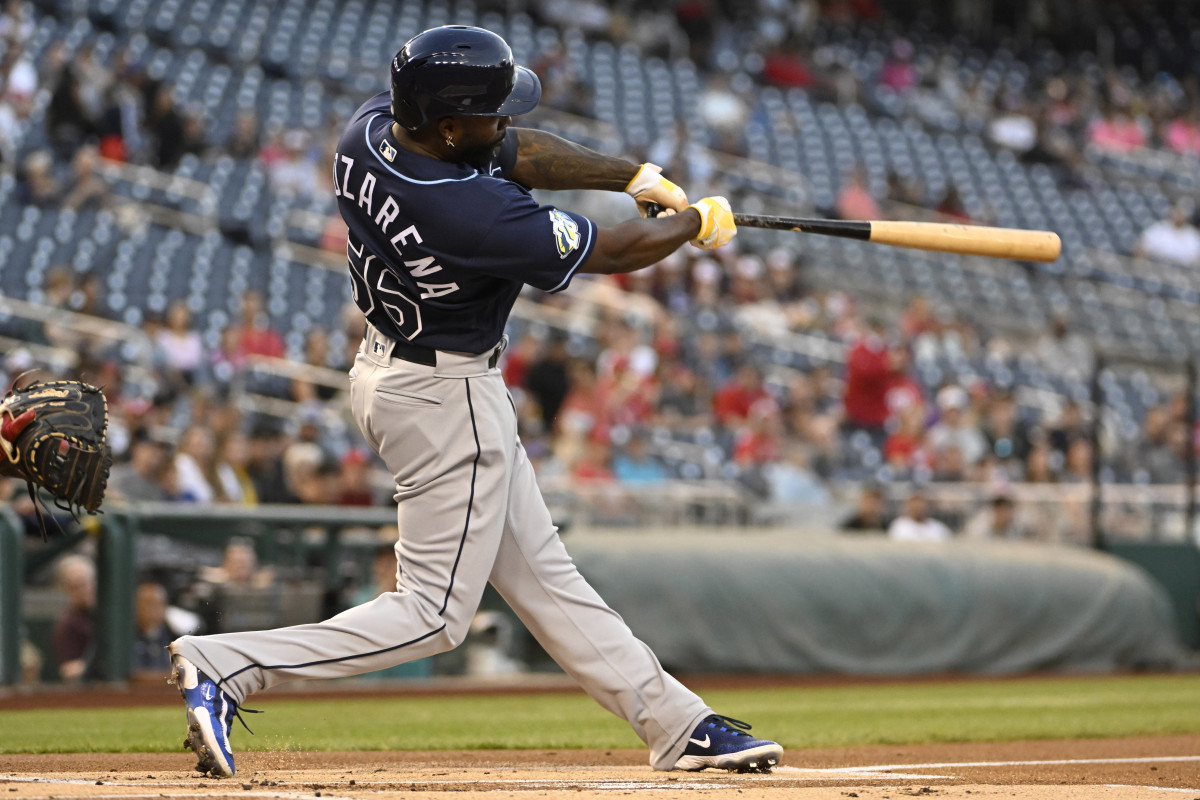Randy Arozarena Is Finally Doing His Homework, and It’s Working

In the seventh inning of the Rays’ 4–1 win over the Pirates last Tuesday, star Tampa Bay left fielder Randy Arozarena did something that surprised his coaches: homework.
Since he debuted in the majors in 2019 with the Cardinals—and especially since he starred for the Rays in ’20 after being traded to Tampa Bay—Arozarena has been famous among his peers for his indifference to his opponents. He had never heard of almost any of the pitchers he faced and he liked it that way. The only scouting report that interested him was not quite one word long: “Velo?” He wanted to know how hard the pitcher threw, not what his name or repertoire was.
So on Tuesday, when Arozarena darted from the plate into the dugout during a mound visit, the Rays’ coaching staff briefly wondered whether he thought there was a pitching change and wanted to sit down and relax. But no: Arozarena grabbed an iPad and called up video of the fastball of Pirates reliever Dauri Moreta.
In the end, whatever Arozarena learned didn’t help him much; he grounded into a double play. But the moment typified the growth that has impressed the people around him.
“That did not happen last year,” says manager Kevin Cash.
Arozarena has always been a good player, especially when the spotlight is brightest. His 1.121 career postseason OPS is third in history among players with at least 120 plate appearances, behind Lou Gehrig and Babe Ruth (both 1.214), and Arozarena had a better World Baseball Classic this spring than anyone else besides Shohei Ohtani. But until recently, Arozarena, 28, relied mostly on his natural talent. This spring, he says, he met with his agent, Scott Boras, who suggested a different approach.
“I’ve been learning a lot about how the business works besides just playing baseball and trying to apply that to my game,” he says through interpreter Elvis Martinez. “[Boras] has a lot of good information that works for me.” Arozarena says he has an eye toward free agency, four years away, and on salary arbitration, for which he becomes eligible after this season. Boras reminded him that a billionaire team owner was more likely to agree to a massive deal with a player who had shown consistency than with one who had shown only flashes of greatness. “But I’d like not to get too far ahead,” Arozarena says.
The present is going pretty well. As the Rays have raced to an MLB-best 28–7 record, through Monday, Arozarena has become one of the most dangerous—and consistent—hitters in the sport. He has hit .328 (third in the AL) and slugged .594 (fourth). His 179 OPS+ is fourth as well. And the underlying numbers suggest he could keep this up: His average exit velocity of 94.8 mph is seventh in baseball, two spots ahead of Blue Jays slugger Vladimir Guerrero Jr.; he’s hitting the ball hard 56.7% of the time, eighth in baseball; and he’s barreling it 20.6% of the time, 11th in the sport. Last year those numbers were: .263 (30th), .445 (27th), and 125 (25th); and 90.1 mph (73rd), 41.3% (105th) and 5.3% (124th). So what is this new information?
“I don’t want to go too much into detail, because then they know what I’m looking for,” he says, smiling. He adds that much of his success stems from better pitch selection.

Boras says that the league believed Arozarena ignored information; the way he saw it, Arozarena just needed to hear information that interested him. Boras ties the improvement in performance to an improvement in focus. “Why are you ready to hit in the postseason?” he asked Arozarena. “You have an extraordinary antenna for being ready to hit in the postseason, in places where you feel you are most needed, you feel is the highest level of competition. Your focus level in those arenas is dramatically extraordinary. … We have got to give you stimulus for the day-to-day.” Arozarena relishes competition, so Boras told him that whether he knew the pitcher or not, the pitcher knew him and was prepared for him. By skipping that level of preparation, he was giving away an opportunity to compete.
The conversation seems to have resonated. “He wants to know a lot, actually,” says assistant hitting coach Brady North. Arozarena came to him and quality control coach Jonathan Erlichman in spring training and asked for his results over the past three seasons in “advantage counts” (1–0, 2–0, 2–1, etc.). Every two or three weeks, the coaches update the presentation, on video and on paper, plus information on how the opposing pitcher tends to attack hitters in those circumstances. Last year, in advantage counts, Arozarena hit .280 and slugged .453; this year, those figures are .367 and .700.
In the past few weeks, Arozarena has been heard discussing pitch shapes and pitchers’ tips, two topics that used to bore him. In fact, a few days ago, North says, the Rays identified a tell in an opponent’s delivery. (He declines to be more precise, he says, because the pitcher is still making the mistake.) “He found a new one, through his studying,” North says. “He said, It’s actually this, and we changed it.”
Arozarena attributes his increased focus on preparation to a shift in mindset, and not the one you might expect. “It might sound selfish, but [in the past] I was playing hard trying to help the person that was coming behind me,” he says. “This year I'm playing harder, playing smarter, to help myself—and to help the team.”
Still, he says he can name only two opposing starting pitchers: the Yankees’ Gerrit Cole and Nestor Cortes Jr. He is not interested in learning any others’ names. They already know his.
